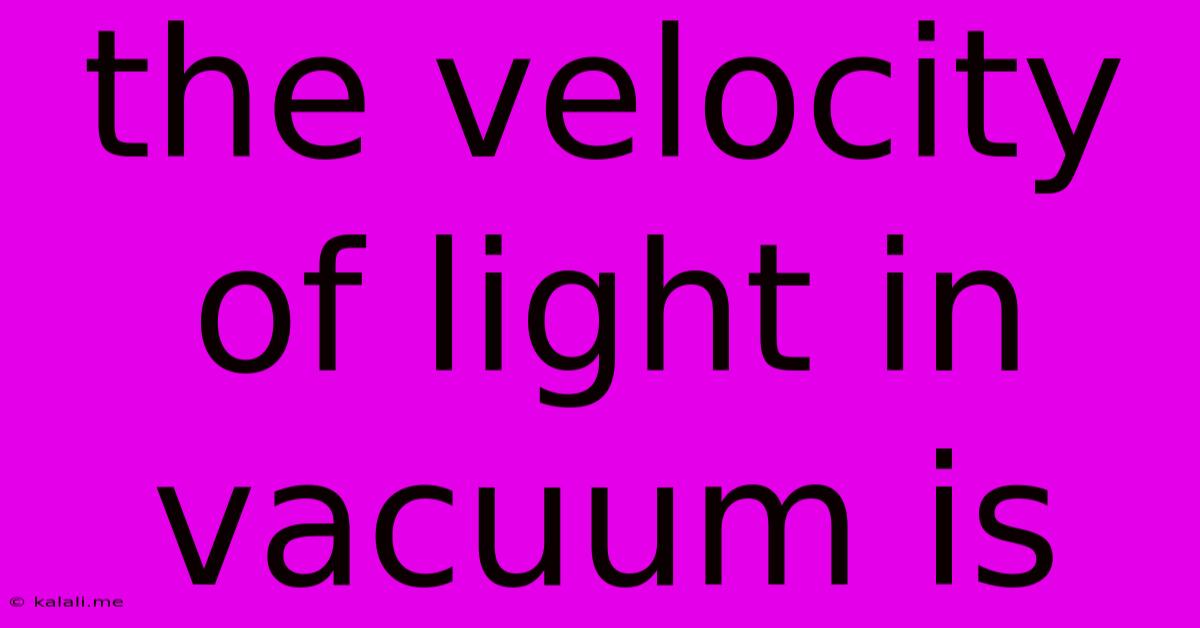The Velocity Of Light In Vacuum Is
Kalali
Jun 15, 2025 · 3 min read

Table of Contents
The Velocity of Light in a Vacuum: A Constant in Our Universe
The speed of light in a vacuum, a fundamental constant in physics, is a cornerstone of our understanding of the universe. This article will delve into its precise value, its significance in various scientific fields, and some of the intriguing implications of its constancy. Understanding the speed of light is key to grasping concepts like special relativity and the vast distances of space.
What is the speed of light in a vacuum?
The speed of light in a vacuum, often represented by the letter 'c', is approximately 299,792,458 meters per second (m/s). This is a remarkably consistent value, regardless of the observer's motion or the light source's movement. This seemingly simple number has profound implications across physics and astronomy.
Why is it a constant?
The constancy of the speed of light is a postulate of Einstein's theory of special relativity. This means it's not something we've derived from other principles; it's a fundamental assumption based on experimental observations. Before Einstein, physicists struggled to reconcile the seemingly contradictory results of experiments involving light and moving objects. Einstein's revolutionary idea was to assume the constant speed of light as a fundamental law, which then led to the fascinating implications of time dilation and length contraction.
The Significance of 'c'
The speed of light isn't just a number; it's a crucial component in many important equations and concepts:
-
Electromagnetism: The speed of light appears in Maxwell's equations, which describe the behavior of electric and magnetic fields. It's directly related to the permeability and permittivity of free space, fundamental constants that characterize the interaction of electric and magnetic fields in a vacuum.
-
Special Relativity: As mentioned, 'c' is central to Einstein's theory of special relativity, which revolutionized our understanding of space and time. It connects space and time into a four-dimensional spacetime continuum, demonstrating their interconnectedness.
-
Energy-Mass Equivalence (E=mc²): This iconic equation, also derived from special relativity, shows the equivalence of energy and mass. The speed of light squared (c²) acts as a conversion factor between the two.
-
Cosmology: The speed of light plays a pivotal role in cosmology. The observable universe is limited by the distance light has had time to travel since the Big Bang. This "cosmological horizon" represents the boundary beyond which we cannot currently observe. Understanding the expansion rate of the universe and the distances to distant galaxies relies heavily on calculations involving the speed of light.
Light's Behavior in Different Media
It's important to note that the speed of light we've discussed is specifically for a vacuum. When light travels through a medium like air, water, or glass, its speed decreases. The refractive index of a material is a measure of how much the speed of light is reduced in that material. This change in speed is responsible for phenomena such as refraction (bending of light) and dispersion (separation of light into its constituent colors).
The Ongoing Pursuit of Precision:
Scientists continue to refine the measurement of the speed of light with ever-increasing accuracy. The current value is incredibly precise, owing to advanced experimental techniques and technological improvements. This ongoing pursuit of precision highlights the fundamental importance of 'c' in our understanding of the universe.
In conclusion, the velocity of light in a vacuum is far more than just a number; it's a fundamental constant that underpins our understanding of the universe's most fundamental laws. From electromagnetism to cosmology, its influence is profound and continues to shape our scientific exploration.
Latest Posts
Latest Posts
-
What Is The Gas Released During Photosynthesis
Jun 15, 2025
-
The Number Of Atoms In 1 Mol Of Carbon Is
Jun 15, 2025
-
At What Speed Does Sound Travel In A Vacuum
Jun 15, 2025
-
What Is The Major Product Of The Following Reaction Hcl
Jun 15, 2025
-
What Wave Has The Shortest Wavelength
Jun 15, 2025
Related Post
Thank you for visiting our website which covers about The Velocity Of Light In Vacuum Is . We hope the information provided has been useful to you. Feel free to contact us if you have any questions or need further assistance. See you next time and don't miss to bookmark.